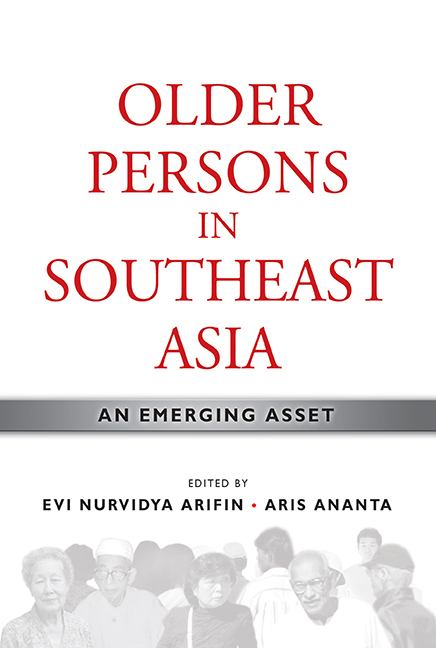Book contents
- Frontmatter
- Contents
- List of Tables
- List of Figures
- Foreword by Hal Hill
- Message from the Director
- Preface
- Contributors
- PART I INTRODUCTION
- PART II OLD-AGE INCOME SECURITY
- PART III EMPLOYMENT AND OTHER SOURCES OF FINANCIAL CONTRIBUTION
- PART IV AGEING, MIGRATION, AND DEVELOPMENT
- 11 The Nexus of Ageing and Migration in Singapore
- 12 Overseas Labour Migration and Well-being of Older Filipinos
- 13 Urbanization and the Ageing Community in Sarawak, Malaysia
- PART V ROLES OF GOVERNMENT AND CIVIL SOCIETY
- Index
11 - The Nexus of Ageing and Migration in Singapore
from PART IV - AGEING, MIGRATION, AND DEVELOPMENT
Published online by Cambridge University Press: 21 October 2015
- Frontmatter
- Contents
- List of Tables
- List of Figures
- Foreword by Hal Hill
- Message from the Director
- Preface
- Contributors
- PART I INTRODUCTION
- PART II OLD-AGE INCOME SECURITY
- PART III EMPLOYMENT AND OTHER SOURCES OF FINANCIAL CONTRIBUTION
- PART IV AGEING, MIGRATION, AND DEVELOPMENT
- 11 The Nexus of Ageing and Migration in Singapore
- 12 Overseas Labour Migration and Well-being of Older Filipinos
- 13 Urbanization and the Ageing Community in Sarawak, Malaysia
- PART V ROLES OF GOVERNMENT AND CIVIL SOCIETY
- Index
Summary
Numerous scholars have studied the demographic ageing process of countries in Southeast Asia (Hermalin 2002; Knodel 2005; Teo et al. 2006; Mehta 2006; Kreager and Schroder-Butterfill 2004; Liu and Kendig 2000; Yoon and Hendricks 2006), but very few have examined the nexus of migration and ageing in these countries. While in some of these countries the rate of internal and international migration has been prominent such as from rural to urban areas, for example, in the Philippines, Indonesia and Thailand, in other countries, in migration of a permanent kind has been distinguishable, for example, Singapore, is a largely migrant society. Malays are recognized as the original settlers here while Chinese, Indians, and other ethnic groups are viewed as immigrants. However, over the centuries the immigrants have settled and called Singapore their “home”. History books have delineated the various waves of immigration into Singapore (see Chew and Lee 1991). British colonial rule in Singapore contributed to large numbers of Indians from South India being “imported” as indentured labourers. Initially, these immigrants dreamt of returning to their homelands, but over time, the different cohorts of immigrants settled and accepted the host country and became citizens. Some literature exists on the history and development of similar North Indian communities in Singapore, such as the Hindustani community (Lal 2006; Rai 2004).
In recent years, transmigration trends have been studied by many scholars in developed and developing countries. Lorente et al. (2005) have examined the trends in the Singapore context and their implications. Labour migration has become a popular subject of study and there are many implications for the country of origin as well as the host country. Legal and illegal immigrants are crossing national borders in search of better economic prospects. Apart from immigration problems, the families that are broken due to the out migration of a parent figure represent a social cost that is borne by spouses, parents, and children. In Singapore, there are approximately 150,000 foreign domestic helpers that support young and ageing families in looking after dependants (Ng 2005, p. 101).
Ageing Population in Singapore
A large proportion of the Singaporean ageing population consists of immigrants who reached the shores of Singapore in the early part of the twentieth century.
- Type
- Chapter
- Information
- Older Persons in Southeast AsiaAn Emerging Asset, pp. 301 - 313Publisher: ISEAS–Yusof Ishak InstitutePrint publication year: 2009

